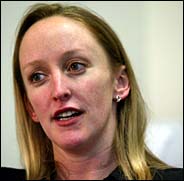A Dispassionate Look at the Wolf in Priest's Clothing
By Daniel J. Wakin
New York Times
March 5, 2004
http://www.nytimes.com/2004/03/05/nyregion/05profile.html
The child sexual abuse scandal was raging through the Roman Catholic Church. The nation's bishops, accused of covering up the sins of their priests, commissioned a study to explore the problem. Many individual bishops fumed. So did victims, worried about a whitewash.
The report came out last week to another storm of scrutiny, and in the middle of it all was Prof. Karen J. Terry.
 |
| "I have no bias. I have no reason to support the church or to support the victims." Prof. Karen J. Terry Photo by Andrea Mohin/The New York Times |
Like an unnoticed reed in the tempest, Professor Terry, 31, an unheralded, self-effacing expert on sexual deviancy, served as the report's principal investigator and author.
For that expertise, we can thank the likes of Tonya Harding, Kristi Yamaguchi and Nancy Kerrigan.
As a girl, Ms. Terry was a nationally competitive figure skater. Those other skaters were just too good, so she chose college instead, which led to the study of psychology and criminology, which led to a doctorate in criminology from Cambridge University, which led to her job as an associate professor at the John Jay College of Criminal Justice.
When the United States Conference of Catholic Bishops alighted on John Jay to carry out the research late in 2002, she was the natural choice to lead the team.
The director of the bishops' Office of Child and Youth Protection provided the outlines of the study. The team created 21 pages of surveys and instructions, and devised complicated confidentiality procedures.
Over the last year, Professor Terry and her researchers fielded hundreds of phone calls, from diocesan officials angered by the surveys or unsure how to fill them out, and from victims, who wanted to report abuse (they were referred to the bishops' child protection office) or simply wanted to hear that they were being counted (yes, if their cases were in a diocesan file).
On Wednesday, Professor Terry was in her John Jay office on 10th Avenue, catching up on work and realizing just how exhausted she was. She shared some basic personal facts: three roommates in a Lower East Side apartment, a financial analyst boyfriend, a puppy.
Professor Terry grew up in Orange County, Calif., and was the first person in her immediate family to go to college (the University of California at Irvine). The daughter of nominally Protestant parents, she calls herself an agnostic. Her teenage years included frequent skating competitions. The highlight was finishing second in the novice division of the national championships in 1986. At Cambridge, she played on the university hockey team. Now, she is a judge for the United States Figure Skating Association.
PROFESSOR TERRY is persistently dispassionate about the subject matter of the study.
"I have no bias," she said. "I have no reason to support the church or to support the victims."
While the study was being conducted, she contended with bishops who resisted cooperating. After its release, she rejected claims by victims' advocates that it was less than valid because it depended solely on what bishops had reported from their files.
Professor Terry said that an independent examination of church files would have been impractical, and that the remarkable consistency of the abuse statistics across the country ruled out the possibility of a broad agreement by bishops to underreport. "I do give the church a lot of credit for doing this," she said. "There is no other institution that has."
Over all, the survey found that from 1950 to 2002, about 4 percent of the nation's priests were accused of sexually molesting minors, a number far higher than many church officials had suggested.
The report contains a wealth of data about the nature of the abuse, its prevalence and the profiles of abusers. In hindsight, Professor Terry said, she wishes that the team had explored more deeply the sexual orientation of the abusive priests, whose victims were overwhelmingly male. Most sexual abuse victims in the general population are female.
Other researchers have praised the John Jay study, but cite shortcomings.
Because all of the data was provided by the nation's dioceses and based on existing files, for example, the John Jay team had no way to standardize definitions or know how the dioceses had chosen which information to include.
"This is the equivalent of a couple of good, interesting articles in a scientific journal," said David Finkelhor, a professor at the University of New Hampshire and another expert in the field.
Professor Terry said she and her colleagues planned to publish peer-reviewed academic articles. "This is the only database of a population of sex offenders anywhere in existence," although plenty of other studies look at samples, she said. "There's a lot you can do with that."
The professor's work places her at the intersection of human psychology and criminal behavior.
"I find it absolutely fascinating, the whole field of deviant sexual behavior," she said. No other type of crime cuts such a swath across society or has such complex causes, she said.
"Intellectually, I can understand the factors leading up to this behavior," she said. But individual motivations remain mysterious.
After some prodding, she concedes that running the priests' study was heady stuff. "This is definitely the most interesting thing I've ever done," she said.
The details of some cases were painful, but her job was to look at the numbers, which created a protective distance.
"It's like a police officer,'' she said. "You learn not to get too emotionally involved in a particular case. And skating helps. You get to go off and judge happy children."
Any original material on these pages is copyright © BishopAccountability.org 2004. Reproduce freely with attribution.